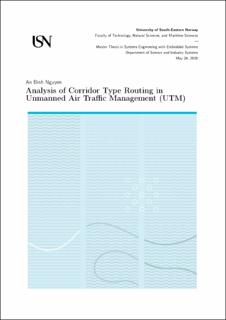| dc.description.abstract | The rise of using unmanned aerial vehicles (UAV) for commercial use has been increased lately, and it is estimated that within 2030 approximately 750 000 drones/UAVs will populate the European airspace. Which means the current air traÿc will increase by 20 times. The growth of UAVs applications will mostly be in the logistics of goods and people, surveillance, inspection, rescue, and agriculture. As most of those applications will take place in densely populated areas, unmanned air traÿc management (UTM) can manage those activities safely and securely while ensuring the quality of life for people and wildlife. At the moment, drone routing in airspace for UTM is centered around free-routing, which means the airspace is unstructured. This kind of free-routing is restricted or forbidden by having a vast volume of UAVs in the airspace. By utilizing structured airspace called corridor-routing, the airspace will be well defined for several types of operation. In this work, we evaluate current state-of-the-art in UAVs operation and integration of UTM.
This study aims to analyze the use of corridor type routing in UTM by going into four topics and proposes a framework that breaks down di˙erent aspects of a corridor-routing in UTM. First, the placement of a corridor is explored by defining very low-level (VLL) airspace as well as separation for the UAVs in the corridor and how the weather could impact the corridor and UAVs. Further on this section the thesis explores scenarios for placing a corridor in a rural area and in an urban area.
Secondly, two types of corridors characterized are analysis, static and dynamic corridors. The analysis looks into what’s di˙erent between the two corridors and which risks are involved when switching between the two corridors. The main di˙erence between static and dynamic is the dynamic corridor could reroute when a no-fly zone is established, and a dynamic corridor could temporarily increase the traÿc by adding a new flight path in the corridor.
Thirdly, the comparison between the three types of the corridor is studied. The three corridors which are analyzed are specific, parallel, and switching. Between all three corridors, the specific and parallel share some common points, as both are a static type, the travel distance and travel time are known. In contrast, the switching corridors are a dynamic type, which is the most flexible corridor among the three. The capacity is limited for a specific corridor as it uses the same principle as a single railway line. For the other two corridors, the capacity is much higher as the parallel corridor utilizes multiple lanes, and the switching corridor uses a dynamic approach with multiple horizontal layers.
On the last topic, the liabilities and risks involved when transferring liabilities are looked into. The main three actors involved are pilots, supervisory control, and traÿc management system. The supervisory control, in this case, is the one regulating the laws like the civil aviation authority in Norway and United Kingdom, and the traÿc management system is the one who is responsible for traÿc planning, monitoring, and communicating with every party that uses the corridor. A risk analysis is given for transferring liability and a mitigation plan for all the risks identified to reduce the impact of the risk. | en_US |
